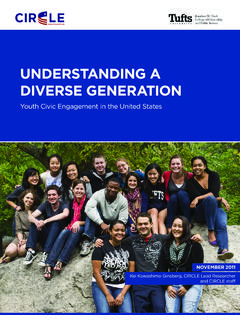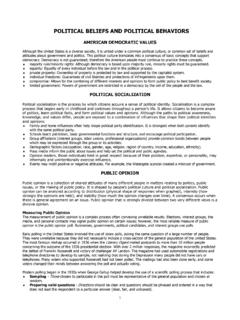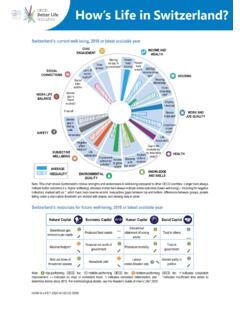Transcription of YOUNG VOTER MOBILIZATION TACTICS - …
1 YOUNGVOTERMOBILIZATIONTACTICSA compilation of the most recent research ontraditional & innovative VOTER turnout techniquesWinning YOUNG VotersThis booklet outlines the best ways to reach and turn out YOUNG voters, fromphone banks to door knocks. Each tactic is evaluated through a randomizedfield experiment in order to determine how much that tactic increases a person slikelihood to vote and for its cost-effectiveness. We also outline what does notwork and is not worth a campaign s time or saw in 2004 that YOUNG people will vote when asked.
2 This booklet gives non-profits and political campaigns the tools to turn out YOUNG voters in 2006and ThemesThemes from the research findings ..5 Case Studies on Turnout TechniquesResearch case studies by tactic (with impact & costs analyses) ..9 Tips for campaignsAdvice based on the research findings ..20 YOUNG VOTER Strategies, a project of the Graduate School of Political Managementat The George Washington University with support from The Pew CharitableTrusts, provides the public, parties, candidates.
3 Consultants and nonprofits withdata on the youth vote and tools to effectively mobilize this electorate forupcoming compilation of the most recent academic research on VOTER mobilizationtechniques is one of many toolkits that YOUNG VOTER Strategies has developed to assist campaigns and organizations in developing their own strategies forengaging the increasingly large youth more information about past reports and upcoming research please visit ourwebsite at booklet was compiled with the help of CIRCLE ( The Center for Informationand Research on Civic Learning and Engagement) at the University of promotes research on the civic and political engagement of Americansbetween the ages of 15 and 25.
4 Although CIRCLE conducts and funds research,not practice, the projects that they support have practical implications for thosewho work to increase YOUNG people s engagement in politics and civic life. CIRCLEis also a clearinghouse for relevant information and scholarship. CIRCLE is fundedby The Pew Charitable Trusts and Carnegie Corporation of New this booklet we have compiled the best and most recent randomized fieldexperiments done on traditional and innovative campaign TACTICS . For eachtactic, we estimate the cost per additional vote and the impact on youngvoters turnout.
5 We start with themes that run through the most successfulturnout tests and end with tips for putting these most effective TACTICS intopractice. We hope you will use this information to better incorporate youngvoters into your campaign plans in the is a randomized field experiment?The community of non-partisan and partisan organizations, foundations andresearchers dedicated to engaging YOUNG voters has been conducting randomizedfield experiments for more than six years to study various types of VOTER contactand quantify their impact.
6 The Pew Charitable Trusts has funded most of thisresearch, conducted in conjunction with scholars at Yale University. In 2004, theBeldon Fund, JEHT Foundation, Carnegie Corporation of New York, and SolidagoFoundation funded additional experiements through CIRCLE. Meanwhile, in2004, The Student PIRGs New Voters Project successfully implemented and tookto scale many findings from the research to randomized field experiments are essentially like running prescription drugtrials for politics, where people in a treatment group get a knock on the door or a phone call and people in the control group do not.
7 After the elections, countyrecords are collected to find out at what rate the treatment and the control groupsvoted and to determine the impact of the door knocking or phone results mean that organizers for youth vote campaigns and politicalcampaigns can predict with reliability the results of their Out YOUNG VotersIn 2004, YOUNG VOTER turnout increased more than in any election since 18 yearolds won the right to vote 35 years ago. Turnout among our nation s youngestvoters ages 18-24 increased 11 percentage points from 36 percent to 47 percent;turnout among 18-29 year olds increased 9 points from 40 percent to 49 percent.
8 ( Census Bureau 2005)This trend continued in 2005 when student-dense precincts in Virginia saw aturnout increase of 15 percent. (New Voters Project and CIRCLE 2005)Leading campaign professionals, analysts and academics agree that one of the keyfactors driving this recent increase in turnout is that there has been, for the firsttime in decades, a major investment in mobilizing these voters. Non-partisanorganizations that ran peer-to-peer field operations, media, and visibilitycampaigns spent an estimated $40 million on registering and turning out youngvoters, a presidential campaign made a media buy targeting YOUNG voters.
9 Andpartisan organizations both inside and outside of the party structures mobilizedsupportive turnout efforts paid off on Election Day 2004 as more than 20 million 18-29 year old voters went to the lesson learned is that today s YOUNG adults are an engaged generation thatwill vote in higher numbers if they are asked. Given their sheer size topping 42million in 2006 and growing rapidly it is a crucial demographic to engage andask to vote. The question now is the most cost-effective wayto ask a YOUNG person to vote?
10 5 Quality countsActual votes per contact will be higher when the contact is more personalizedand research shows that the most effective method of generating a new voteris an in-person door knock by a peer. The next greatest impact was seen byphonebanks with longer, chattier phone scripts or volunteers making thecalls. Also, recent survey data by YOUNG VOTER Strategies shows that the onlinetools that are most effective are the ones where the YOUNG VOTER either opts-into the conversation or gets to interact in some Section II case studies demonstrate that the less personal and interactiveoutreach TACTICS are, the less effective they are in turning out voters.








